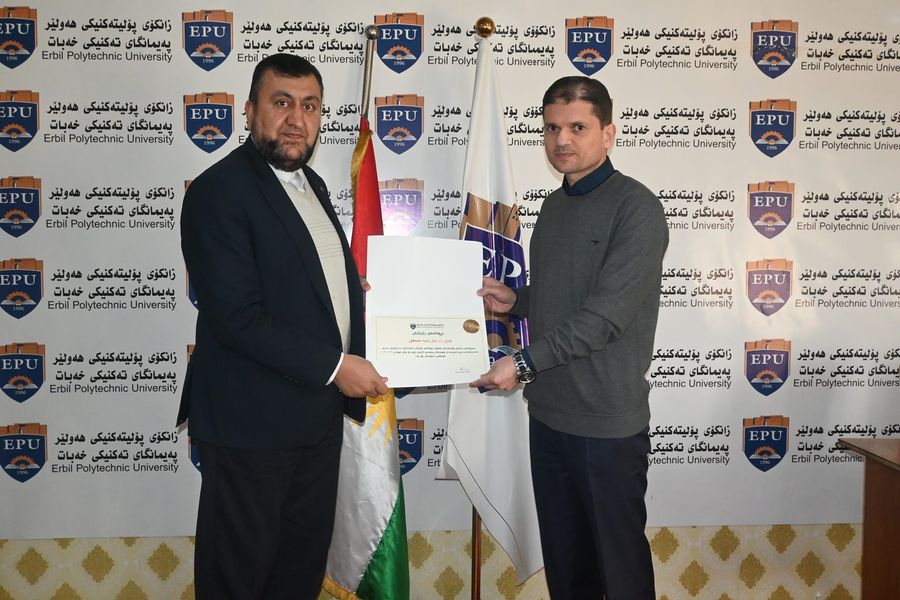On Sunday 21/01/2024,The tribute of the Rector of Erbil Polytechnic University distributed awards to the successful teachers of the quality assurance process for the academic year (2022-2023) by the representative of the Dean of the Institute, Dr. Mawloud Khader, Assistant Dean.
-
Aso Mohammed Aladdin -
aso.dei20@epu.edu.iq - +9647725426616
- phd-dissertation-last-draft-Aso
-
The evolutionary sophistication method solves optimization problems; however, its effectiveness and scalability can be challenged as problem complexity increases. Population-based evolutionary metaheuristic algorithms heavily rely on operators that determine their overall performance. These operators enhance exploration and exploitation, crucial for effective search and optimization. The research introduces the crossover operator, Lagrangian Problem Crossover (LPX), to boost evolutionary algorithms' performance in tackling new optimization problems. Additionally, it presents Lagrange Elementary Optimization (LEO), a single-objective algorithm where LPX plays a significant role.
The crossover operator in population-based algorithms is crucial for selecting suitable solutions in optimization processes. Its efficiency saves time, minimizes errors, and reduces costs in engineering applications. The initial phase of the study presents an overview of the current crossover methods utilized in engineering operations and problem representation. Furthermore, presenting LPX, it is a fresh and inventive hybrid technique that draws inspiration from the principles of the Lagrangian Dual Function (LDF). Experimental evaluations compare LPX with other standards such as Simulated Binary Crossover (SBX), Blended Crossover (BX), and Qubit-Crossover (Qubit-X) in real-coded crossovers. The results indicate that LPX generally outperforms other methods and shows comparable performance in remaining cases. Specifically, in TF7, LPX demonstrates superior performance and shorter computation time across all three random values compared to Mean (α=0.2) at 0.0048, Standard Deviation (α=0.2) at 0.0031, and time computation (α=0.2) at 143.005 units. Statistical analysis validates the significance and reliability of LPX compared to other crossover standards.
In the second phase of the research, a novel evolutionary method named Leo is introduced. Leo is inspired by the accurate vaccination process that utilizes the human blood albumin quotient. Leo utilizes a self-adaptive approach, evolving intelligent agents through gene crossover based on fitness function values. The algorithm's accuracy and precision are extensively validated through rigorous testing on diverse benchmark functions, including both traditional and CECC06 2019 benchmarks. Leo's performance is benchmarked against well-known algorithms like Dragonfly, Genetic Algorithm, Practical Swarm Optimization, and others across multiple functions. A comprehensive comparison evaluates Leo's effectiveness and efficiency in solving optimization problems against these established algorithms. In optimizing multimodal test functions (TF8-TF13), particularly TF11, the proposed approach outperformed other algorithms, with an average TF11 value of (2.7393E-08). Notably, across the composite test functions (TF14-TF19), the proposed method exhibited consistently high performance compared to the base algorithms. The statistical analysis supports the research conclusions, and real-world applications of Leo are also showcased. The stability of Leo is confirmed using standard metrics for exploration and exploitation.
-
Erbil Technical Engineering College -
Information Systems Engineering -
Information Systems Engineering
-
Safar Maghdid Asaad -
safar.asaad14@gmail.com - +9647501206882
-
In the Internet of Things (IoT) era, tracking humans’ daily life activities has faced a remarkable transformation, especially in terms of indoor positioning. Similarly, wireless positioning technologies, including Wi-Fi and LoRa, have been employed as an alternative to Global Navigation Satellite System (GNSS) technologies for indoor tracking. Wi-Fi and LoRa positioning frequently employs the received signal strength indicators (RSSI) of the Wi-Fi and LoRa signals. However, the RSSI-based approachs suffer from Multipath, Non-Line-Of-Sight (NLOS), and fluctuating RSSI measurements via Wi-Fi and LoRa chipsets. When these issues have the direct impact on the accuracy and reliability of the positioning techniques. In addition, the fingerprinting procedure is one of the most widely known positioning methods for RSSI- based techniques. Due to the absence of a stable matching algorithm, the fingerprinting-based method has an additional issue.
There are a number of matching algorithms, for example, weighted k- nearest neighbour (WkNN), k-mean clustering, decision tree, and deep learning algorithms such as Long-Short-Term Memory (LSTM). Two algorithms are proposed in this study to provide adequate positioning services.
The first algorithm is a novel integrated matching algorithm for Wi-Fi fingerprint-positioning technique, which is known as Norm_MSATE_LSTM, as a means of mitigating the drawbacks of the RSSI-based fingerprinting method. It is based on the Wi-Fi fingerprinting and proposed augmentation techniques with considering LSTM as a matching technique. To address the problem of a large number of RPs/classes in the LSTM, we first conduct the augmentation process to boost the RSSI data records using the Mean Standerd deviation Augmentation TEchnique (MSATE). The RSSI data are normalised (Norm), and the long short-term memory (LSTM) method is used to estimate the accurate positions. Finally, the recommended matching algorithm is compared with the stand-alone matching algorithms, including weighted k- nearest neighbours (WkNN) and LSTM.
The second algorithm is the hybrid positioning technique using existing Wi-Fi and LoRa technologies, which is known as Wi-Lo, and it is aimed at improving the outcomes of the first suggested algorithm. This one is based on the combination of the Wi-Fi and LoRa technologies and considering MM and trilateration techniques to provide seamless positioning from outdoor to indoor via building identifications. The approach is divided into two phases. The LoRa RSSI is used to identify buildings in the first phase. The second phase is known as Wi-Lo, and it combines LoRa and Wi-Fi technologies to improve Norm_MSATE_LSTM positioning accuracy outcomes.
Experiments and simulated investigations indicate that the proposed matching algorithm, Norm_MSATE_LSTM, may increase positioning accuracy of the LSTM by 45.83% and 72% when only augmentation and augmentation with normalisation are applied, respectively. On the other hand, the proposed Wi-Lo can increase the first algorithm’s accurate by 39.74% in terms of the positioning improvement.
-
Erbil Technical Engineering College -
Information Systems Engineering



